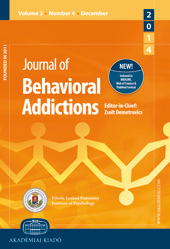DSM-5 criteria for gambling disorder: Underlying structure and applicability to specific groups of gamblers
DSM-5 criteria for gambling disorder: Underlying structure and applicability to specific groups of gamblers
Author(s): Pawel Sleczka, Barbara Braun, Daniela Piontek, Gerhard Bühringer, Ludwig KrausSubject(s): Comparative Psychology, Behaviorism, Methodology and research technology, Substance abuse and addiction
Published by: Akadémiai Kiadó
Keywords: gambling disorder; DSM-5; IRT; criterion bias;
Summary/Abstract: DSM-5 provides nine diagnostic criteria for gambling disorder. All criteria have a pre-assumed equal diagnostic impact and are applied to all individuals and groups in an equal manner. The aims of the study are to analyse the structure underlying the diagnosis and to assess whether DSM-5 is equally applicable to different groups of gamblers. Methods: Data from the 2009 German Epidemiological Survey of Substance Abuse and from a study on slot machine gamblers were used. Item Response Theory analysis was applied to estimate discrimination and severity parameters of the criteria. With the use of Differential Item Functioning analysis, potential criterion biases were analysed.We analysed data from 107 participants from the general population sample and 376 participants from the slot machine gamblers’ sample who answered a 19-item diagnostic questionnaire based on the DSM criteria for gambling disorder. Results: A single underlying factor, the severity of gambling disorder, was identified in both samples. In the general population sample the criteria of preoccupation and chasing were least severe and showed low discriminatory power. Bailout, withdrawal and jeopardized matters criteria had highest severity and discriminatory power. The comparison of the two samples revealed two criterion biases in the preoccupation and tolerance criteria. Conclusions: The structure underlying the criteria is unidimensional but the disorder is manifested differently depending on disorder severity. The assumed equal impact of each criterion lacks support in the findings. The DSM-5 criteria measure a partially different construct in slot machine gamblers than in gamblers in the general population.
Journal: Journal of Behavioral Addictions
- Issue Year: 4/2015
- Issue No: 4
- Page Range: 226-235
- Page Count: 10
- Language: English

